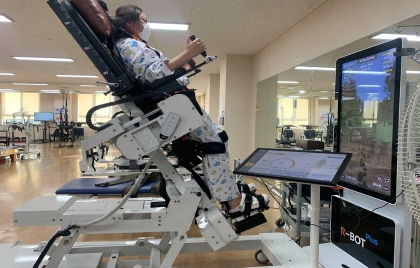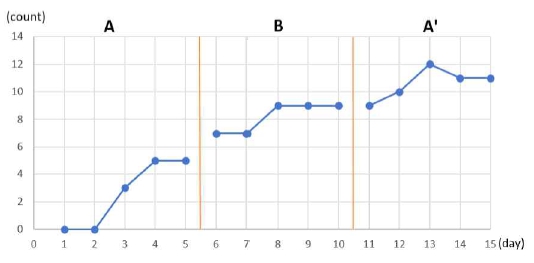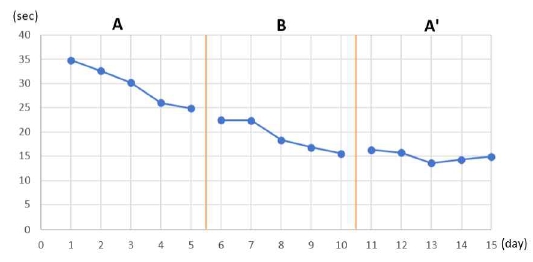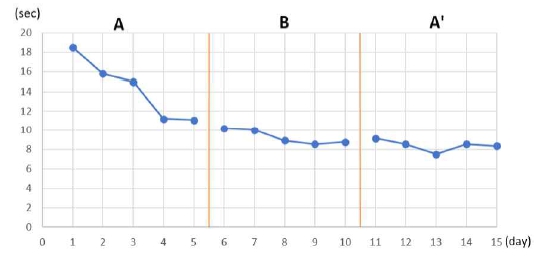
발달성 엉덩관절 이형성증으로 인한 엉덩관절 전치환술 후 로봇치료가 환자의 기능에 미치는 영향: 사례연구
© 2023 by the Korean Physical Therapy Science
Abstract
The advantages of robotic therapy have recently been attempted several times in the rehabilitation of total hip arthroplasty (THA) patients. Therefore, this study also aims to report a case of how robot therapy affects the function of THA patients due to developmental dysplasia of the hip (DDH).
Case Study.
This study used the A-B-A' design. Period A is before robotic therapy, period B is robotic therapy, and period A` is after robotic therapy. The subjects performed physical therapy and occupational therapy for five days each during the baseline period A and A`. In intervention period B, robotic therapy was performed for five days along with the baseline intervention. This study was conducted for a total of fifteen days. The subjects' sit to stand (STS), timed up and go (TUG), and 10 metre walk (10MW) were evaluated.
STS and TUG were significantly improved in periods B and A' compared to period A (p<0.05), and STS was significantly improved in period A' compared to period B (p<0.05). 10MW showed no significant improvement in periods B and A' compared to period A.
This study confirmed that robot therapy was an effective intervention in improving the function of women in their 30s who underwent THA due to DDH. In the future, a study comparing the control group should be performed.
Keywords:
Developmental Dysplasia of the Hip, Robotic Rehabilitation, Total Hip ArthroplastyⅠ. 서 론
발달성 엉덩관절 이형성증(Developmental Dysplasia of the Hip; DDH)은 탈구, 아탈구 및 불안정성, 넙다리뼈 머리 및 절구 이형성을 포함하여 성장하는 엉덩관절과 관련된 기형의 전체 범위를 설명한다(Kotlarsky 등, 2015). DDH는 소아에서 발견되어 치료할 수 있지만(Yang 등, 2019), 청소년기 및 성인기까지 DDH가 지속되면 비정상적인 보행, 근력 감소, 다리길이 차이, 퇴행성관절염, 척추옆굽음증, 허리통증을 유발할 수 있다(Lai 등, 1997; Thomas, 2015; Wedge과 Wasylenko, 1978; Wedge과 Wasylenko, 1979; 최용길 등, 2021). 그러므로 청소년 및 성인에서 발견되고 증상이 지속되면 엉덩관절 전치환술(Total Hip Arthroplasty; THA)과 같은 수술적 치료를 받게 된다(Schmitz 등, 2020; Wang, 2019).
THA 후에는 재활이 중요하다(Piscitelli 등, 2012). 재활에는 몇 가지 주요 요인이 있는데, 그 중 첫 번째는 재활운동 방법이다. 체중부하 운동치료는 수술 후 환자의 관절가동범위와 보행능력을 향상시킨다(Roos, 2003). 그러므로 물리치료사는 환자에게 중재하는 운동치료 중 체중부하 운동치료를 선호한다(Okoro 등, 2013). 두 번째는 재활을 시작하는 시기이다. 수술 후 조기 재활은 입원 기간을 단축, 비용을 줄이며, 관절가동범위, 근력, 그리고 보행능력을 향상 시키는 장점이 있다(Marchisio 등, 2020; Masaracchio 등, 2017; Matheis과 Stoggl, 2018). 따라서, 수술 후 재활 시기가 환자에게 영향을 미치므로 중요하다(Min 등, 2021).
기존의 THA 후 조기 재활과 체중부하를 중재한 선행연구에서는 목발 또는 손잡이를 잡고 서서 운동치료를 실시하거나 누운상태에서 운동치료를 실시하였다(Hesse 등, 2003; Matheis과 Stoggl, 2018). 이런 경우 환자에게 낙상이 발생 시 탈구의 위험성이 있거나 누운 상태에서 운동치료는 체중부하를 적용할 수 없는 한계가 있다. 선행연구들의 한계점을 보완하며 조기 재활과 체중부하를 중재할 수 있는 방법으로는 로봇치료가 있다. 로봇치료는 물리치료사의 치료에 대한 오차를 줄이며 정확한 움직임을 반복적으로 할 수 있는 장점이 있다(전민호과 인진화, 2013). 이러한 로봇치료의 장점을 이용하여 신경계 질환 환자에게 많은 연구가 진행되었다(Calabrò 등, 2021; Gonzalez 등, 2021; Mekki 등, 2018). 최근에는 로봇치료가 THA를 한 환자의 재활에도 적용되고 있다.
THA를 한 환자에게 로봇치료를 적용한 선행연구를 살펴보면, 모바일 기반 로봇이 환자가 목발 보행 시 앞에서 보행을 분석하는 연구로 환자를 보조할 수 없는 한계가 있다(Rohner 등, 2021). 다른 선행 사례 연구에서는 착용형 웨어로블 로봇으로 환자의 보행에 도움을 주지만 체중지지를 해줄 수 없는 한계가 있으며(Koseki 등, 2019), 체중지지가 가능한 기립경사로봇을 사용한 사례연구에서는 결과 값이 불규칙하여 통계적 분석을 하지 못한 한계가 있었다(Kim 등, 2021). THA 후 환자의 재활에 로봇치료를 이용한 연구가 보고되었지만 환자의 체중부하 보조와 조기 재활에 적용한 연구는 부족한 실정이다.
따라서 본 연구의 목적은 로봇치료가 DDH로 인해 THA를 한 환자의 기능적인 측면에 어떤 영향을 미치는지 사례를 보고하는 것이다.
Ⅱ. 연구방법
1. 연구설계
본 연구는 단일 사례 연구의 A-B-A` 설계를 사용하였다. 로봇치료 전 기간인 A와 로봇치료 후 기간인 A`는 기초선 기간으로 물리치료와 작업치료만 각각 5일간 시행되었다. 로봇치료 중재기간인 B에서는 기초선 중재와 함께 기립경사로봇 치료가 5일간 함께 시행되었다. 본 연구는 총 15일간 진행되었다.
2. 연구대상자
본 연구의 대상자는 2022년 5월에 광주광역시 G병원에 입원한 30대 여성이다. 연구 대상자에 대한 설명은 표와 같다<Table 1>. 연구 대상자는 본 연구의 내용에 대하여 충분히 설명을 듣고, 참여에 대한 자발적 동의 후 연구가 진행되었다.
3. 평가
앉았다 일어서기(Sit To Stand; STS)는 기능 수준을 평가하기 위해 사용되었다(Gill 등, 2012). 바닥에서 45cm 높이의 의자에 앉아있는 상태에서 대상자는 어깨넓이로 발을 벌린 후 30초동안 앉았다 일어서기를 반복한 횟수를 측정하였다. 되도록 금기자세를 지키면서 시행할 수 있도록 하였으며 견디기 힘든 통증이 발현 될 경우 대상자는 중간에 포기할 수 있다고 전달하였다.
일어서서 걷기(Timed Up and Go; TUG)는 균형 수준을 평가하기 위해 사용되었다(Yuksel 등, 2021). 등받이가 있는 의자에 대상자는 바른 자세로 앉아 있다가 출발 신호에 맞춰 보조도구를 이용한 보행으로 3m 거리의 반환점을 돌아 안전하게 의자로 돌아와 앉는 지점까지의 시간을 측정하였다.
10m 걷기(10 Metre Walk; 10MW)는 보행 수준을 평가하기 위해 사용되었다(Hollman 등, 2008). 대상자는 총 10M 거리에서 가속기 2m, 감속기 2m를 제외한 중간 6m를 걷는 시간을 측정되었다. 평가자는 대상자에게 “평소 걷는 편안한 속도로 걸어가세요.”라고 전달 하고, 2m 표식점을 지나는 시점에서 8m 표식점에 도달하는 시점까지의 시간을 측정하였다.
4. 중재
본 연구의 전체 기간 A-B-A`에 물리치료와 작업치료가 중재되었다. 물리치료는 균형 및 안정화 운동 위주의 치료가 150분 동안 중재되었다. 작업치료는 금기자세에 대한 교육 및 보조도구 사용 방법, 자세 변화와 일상생활훈련, 자동차 승하차 훈련이 90분 동안 중재되었다.
5. 자료분석
본 연구에서 자료분석은 A-B-A` 전체 기간 중 기초선 A와 중재기간 B, 기초선 A와 기초선 A`, 중재기간 B와 기초선 A`기간의 차이를 비교하였다. 사례연구의 분석 방법인 표준편차 2배 방법을 사용하여 분석하였다(Tanabe 등, 2022). 표준편차 2배 방법은 B 중재기간의 평균이 기초선 A기간의 평균에서 기초선 A기간의 표준편차의 2배 이상 차이가 나면 유의미한 것으로 분석한다(p<0.05).
Ⅲ. 연구결과
1. 앉았다 일어서기
STS의 결과는 다음과 같다(Figure 2). STS는 기초선 A기간(2.6+2.510 회)에 비해 중재기간 B기간(8.2+1.095 회)에서 유의하게 증가하였고(p<0.05), 기초선 A`기간(10.6+1.140 회)에 유의하게 증가하였다(p<0.05). 기초선 A`기간은 중재기간 B기간에 비해 유의하게 증가하였다(p<0.05).
2. 일어서서 걷기
TUG의 결과는 다음과 같다(Figure 3). TUG는 기초선 A기간(29.71+4.247 초)에 비해 중재기간 B기간(19.1+3.187초)에서 유의하게 감소하였고(p<0.05), 기초선 A`기간(14.96+1.088 초)에 유의하게 감소하였다(p<0.05). 기초선 A`기간은 중재기간 B기간에 비해 유의한 차이가 없었다(p>0.05).
Ⅳ. 고 찰
본 연구에서는 기립경사로봇을 이용한 로봇치료가 DDH이후 THA를 실시한 젋은 여성의 기능적인 측면에 미치는 영향 사례를 보고 하고자 하였다. 본 연구 결과 STS와 TUG는 기초선 A기간에 비해 중재기간 B기간에서 개선되었고, 기초선 A`기간에 효과가 유지되었다. STS만 기초선 A`기간이 중재기간 B기간에 비해 유의하게 증가하였다. 10MW는 기초선 A기간에 비해 중재기간 B기간과 기초선 A`기간에 유의한 개선을 보이지 않았다.
STS가 지속적인 향상을 나타내는 결과는 THA 후 저항, 체중지지, 원격, 그리고 일반 운동 중재를 실시한 연구들과 유사한 결과를 나타냈다(Kalron 등, 2018; Mikkelsen 등, 2014; Tsukagoshi 등, 2014). 본 연구에서도 로봇치료가 없는 기초선 기간에도 균형 및 안정화 운동이 매일 중재되었다. 본 연구에서 사용된 운동치료는 선행연구들의 운동치료와 유사하다. 그렇기 때문에 로봇치료를 중지 했음에도 기초선 A`기간에 지속적인 향상을 보였을 것으로 생각된다.
TUG 결과는 엉덩관절 무혈성괴사로 인해 THA후 로봇치료를 실시한 사례연구의 결과와 유사한 결과를 나타내었다(Kim 등, 2021). THA 후 환자들은 균형능력에 제한이 있다(Warenczak과 Lisinski, 2019). THA 환자들은 수술 전에도 근력이 감소하지만 수술 후에도 더욱 근력이 감소한다(Holm 등, 2013; Reardon 등, 2001). 본 연구 대상자도 입원 첫날 엉덩관절 굽힘과 폄에 대한 근력이 F 였다. THA 환자의 운동치료는 근력 향상이 균형능력을 개선 시킬 수 있으며(Winther 등, 2020), 로봇치료 시 엉덩관절의 굽힘과 폄의 반복수축으로 근력과 고유수용성감각이 개선되어 균형 능력이 개선되었다고 생각된다.
10MW 결과는 그래프에서 향상된 모습을 보여주지만 통계적 분석에서는 유의한 결과가 나타나지 않았다. THA 후 로봇치료를 실시한 사례연구에서 보행은 3주 후 부터 유의한 결과를 나타냈다(Koseki 등, 2019). 본 연구의 실험기간이 15일 이므로 3주 후 부터 유의한 결과를 나타낸 선행연구와 유사한 결과라고 생각된다. 선행연구의 결과처럼 보행을 향상시키기 위해서는 충분한 시간이 필요하다. 충분한 시간이 필요한 이유는 보행에 영향을 미치는 변수가 많고(Fukuchi 등, 2019), 수술로 인한 인체의 구조도 회복이 시간이 필요하기 때문에 10MW 결과는 유의한 감소가 나타나지 않았다고 생각된다.
본 연구는 몇 가지 한계가 있다. 첫째, 사례연구이기 때문에 대조군이 없어 정확한 효과를 비교할 수 없었다. 둘째, 엉덩관절 수술한 환자는 회복기 병원에 한 달간 입원이 가능하지만 로봇치료를 5일 밖에 진행되지 않았다. 향후에는 로봇치료가 THA 환자에게 안전성과 타당성을 확인하는 예비연구가 필요하다.
Ⅴ. 결 론
본 연구는 DDH로 인해 THA를 실시한 30대 여성에게 로봇치료를 실시한 사례연구이다. 그 결과 연구대상자의 STS와 TUG가 기초선 A기간 보다 로봇치료 B기간에 로봇치료가 효과적인 중재였음을 확인하였다. 향후에는 로봇치료를 다른 원인으로 THA를 실시한 연구대상자에게도 연구가 필요하며, THA를 수술한 환자 집단을 대상으로 무작위대조연구(Randomized Controlled Trials)를 통해 로봇치료에 대한 임상적 근거를 확보하는 연구가 진행되어야 한다.
References
- 전민호, 이진화. 뇌질환 환자의 로봇 재활치료. 대한의사협회지. 2013;56(1):23-29.
- 최용길, 이상열. (2021). 클램운동 시 허리불안정성 유무가 골반 돌림 및 엉덩관절 벌림근 근활성도에 미치는 영향. 대한물리치료과학회지, 2021;28(1):23-32.
- Calabrò RS, Sorrentino G, Cassio A, et al. Robotic-assisted gait rehabilitation following stroke: a systematic review of current guidelines and practical clinical recommendations. Eur J Phys Rehabil Med. 2021;57(3):460-71.
-
Duarte M, Fukuchi CA, Fukuchi RK,. Effects of walking speed on gait biomechanics in healthy participants: a systematic review and meta-analysis. Syst Rev. 2019;8(1):153.
[https://doi.org/10.1186/s13643-019-1063-z]

-
Gill SD, de Morton NA, Burney HM. An investigation of the validity of six measures of physical function in people awaiting joint replacement surgery of the hip or knee. Clin Rehabil. 2012;26(10):945-51.
[https://doi.org/10.1177/0269215511434993]

-
Gonzalez A, Garcia L, Kilby J, et al. Robotic devices for paediatric rehabilitation: a review of design features. Biomed Eng Online 2021;20(1):89.
[https://doi.org/10.1186/s12938-021-00920-5]

-
Hesse S, Werner C, Seibel H, et al. Treadmill training with partial body-weight support after total hip arthroplasty: a randomized controlled trial. Arch Phys Med Rehabil. 2003;84(12):1767-73.
[https://doi.org/10.1186/s12938-021-00920-5]

-
Hollman JH, Beckman BA, Brandt RA, et al. Minimum detectable change in gait velocity during acute rehabilitation following hip fracture. J Geriatr Phys Ther. 2008;31(2):53-6.
[https://doi.org/10.1519/00139143-200831020-00003]

-
Holm B, Thorborg K, Husted H, et al. Surgery-induced changes and early recovery of hip-muscle strength, leg-press power, and functional performance after fast-track total hip arthroplasty: a prospective cohort study. PLoS One. 2013;8(4):e62109.
[https://doi.org/10.1371/journal.pone.0062109]

-
Kalron A, Tawil H, Peleg-Shani S, et al. Effect of telerehabilitation on mobility in people after hip surgery: a pilot feasibility study. International journal of rehabilitation research. Int J Rehabil Res. 2018;41(3):244-50.
[https://doi.org/10.1097/MRR.0000000000000296]

-
Kim SY, Kim BG, Cho WS, et al. Effects of gait training using a robot for balance in total hip arthroplasty patients after bilateral avascular necrosis: a case study. J Kor Phys Ther. 2021;33(5):231-7.
[https://doi.org/10.18857/jkpt.2021.33.5.231]

-
Koseki K, Mutsuzaki H, Yoshikawa K, et al. Gait training using the honda walking assistive device® in a patient who underwent total hip arthroplasty: a single-subject study. Medicina (Kaunas). 2019;55(3):69.
[https://doi.org/10.3390/medicina55030069]

-
Kotlarsky P, Haber R, Bialik V, et al. Developmental dysplasia of the hip: what has changed in the last 20 years? World J Orthop. 2015;6(11):886-901.
[https://doi.org/10.5312/wjo.v6.i11.886]

- Lai KA, Lin CJ, Su FC. Gait analysis of adult patients with complete congenital dislocation of the hip. J Formos Med Assoc. 1997;96(9):740-4.
-
Marchisio AE, Ribeiro TA, Umpierres CSA, et al. Accelerated rehabilitation versus conventional rehabilitation in total hip arthroplasty (ARTHA): a randomized double blinded clinical trial. Rev Col Bras Cir. 2020;47:e20202548.
[https://doi.org/10.1590/0100-6991e-20202548]

-
Masaracchio M, Hanney WJ, Liu X, et al. Timing of rehabilitation on length of stay and cost in patients with hip or knee joint arthroplasty: A systematic review with meta-analysis. PLos One. 2017;12(6):e0178295.
[https://doi.org/10.1371/journal.pone.0178295]

-
Matheis C, Stöggl T. Strength and mobilization training within the first week following total hip arthroplasty. J Bodyw Mov Ther. 2018;22(5):519-27.
[https://doi.org/10.1016/j.jbmt.2017.06.012]

-
Mekki M, Delgado AD, Fry A, et al. Robotic Rehabilitation and Spinal Cord Injury: a Narrative Review. Neurotherapeutics. 2018;15(3):604-17.
[https://doi.org/10.1007/s13311-018-0642-3]

-
Mikkelsen LR, Mechlenburg I, Søballe K, et al. Effect of early supervised progressive resistance training compared to unsupervised home-based exercise after fast-track total hip replacement applied to patients with preoperative functional limitations. A single-blinded randomised controlled trial. Osteoarthritis Cartilage. 2014;22(12):2051-58.
[https://doi.org/10.1016/j.joca.2014.09.025]

-
Min KH, Beom JW, Kim BR, et al. Clinical practice guideline for postoperative rehabilitation in older patients with hip fractures. Ann Rehabil Med. 2021;45(3):225-59.
[https://doi.org/10.5535/arm.21110]

-
Okoro T, Ramavath A, Howarth J, et al. What does standard rehabilitation practice after total hip replacement in the UK entail? results of a mixed methods study. BMC Musculoskelet Disord. 2013;14:91.
[https://doi.org/10.1186/1471-2474-14-91]

-
Piscitelli P, Iolascon G, Di Tanna G, et al. Socioeconomic burden of total joint arthroplasty for symptomatic hip and knee osteoarthritis in the Italian population: a 5-year analysis based on hospitalization records. Arthritis Care Res (Hoboken). 2012;64(9):1320-27.
[https://doi.org/10.1002/acr.21706]

-
Reardon K, Galea M, Dennett X, et al. Quadriceps muscle wasting persists 5 months after total hip arthroplasty for osteoarthritis of the hip: a pilot study. Intern Med J. 2001;31(1):7-14.
[https://doi.org/10.1046/j.1445-5994.2001.00007.x]

-
Röhner E, Mayfarth A, Sternitzke C, et al. Mobile Robot-Based Gait Training after Total Hip Arthroplasty (THA)Improves Walking in Biomechanical Gait Analysis. J Clin Med. 2021;10(11):2416.
[https://doi.org/10.3390/jcm10112416]

-
Roos EM. Effectiveness and practice variation of rehabilitation after joint replacement. Curr Opin Rheumatol. 2003;15(2):160-2.
[https://doi.org/10.1097/00002281-200303000-00014]

-
Schmitz MR, Murtha AS, Clohisy JC, et al. Developmental Dysplasia of the Hip in Adolescents and Young Adults. J Am Acad Orthop Surg. 2020;28(3):91-101.
[https://doi.org/10.5435/JAAOS-D-18-00533]

-
Tanabe J, Amimoto K, Sakai K, et al. Effects of kinesthetic illusion induced by visual stimulation on the ankle joint for sit-to-stand in a hemiparesis stroke patient: ABA' single-case design. J Phys Ther Sci 2022;34(1):65-70.
[https://doi.org/10.1589/jpts.34.65]

-
Thomas SR. A review of long-term outcomes for late presenting developmental hip dysplasia. Bone Joint J. 2015;97-B(6):729-33.
[https://doi.org/10.1302/0301-620X.97B6.35395]

- Tsukagoshi R, Tateuchi H, Fukumoto Y, et al. Functional performance of female patients more than 6 months after total hip arthroplasty shows greater improvement with weight-bearing exercise than with non-weight-bearing exercise. Randomized controlled trial. Eur J Phys Rehabil Med. 2014;50(6):665-75.
-
Wang Y. Current concepts in developmental dysplasia of the hip and total hip arthroplasty. Arthroplasty 2019;1(1):2.
[https://doi.org/10.1186/s42836-019-0004-6]

-
Wareńczak A, Lisiński P. Does total hip replacement impact on postural stability? BMC Musculoskelet Disord. 2019;20(1):229.
[https://doi.org/10.1186/s12891-019-2598-9]

-
Wedge JH, Wasylenko MJ. The natural history of congenital dislocation of the hip: a critical review. Clin Orthop Relat Res. 1978;137:154-162.
[https://doi.org/10.1097/00003086-197811000-00024]

-
Wedge JH, Wasylenko MJ. The natural history of congenital disease of the hip. J Bone Joint Surg Br. 1979;61-B(3):334-8.
[https://doi.org/10.1302/0301-620X.61B3.158025]

-
Winther SB, Foss OA, Klaksvik J, et al. Increased muscle strength limits postural sway during daily living activities in total hip arthroplasty patients. Am J Phys Med Rehabil. 2020;99(7):608-12.
[https://doi.org/10.1097/PHM.0000000000001382]

-
Yang S, Zusman N, Lieberman E, et al. Developmental dysplasia of the hip. Pediatrics. 2019;143(1):e20181147.
[https://doi.org/10.1542/peds.2018-1147]

-
Yuksel E, Unver B, Kalkan S, et al. Reliability and minimal detectable change of the 2-minute walk test and timed up and go test in patients with total hip arthroplasty. Hip Int. 2021;31(1):43-9.
[https://doi.org/10.1177/1120700019888614]





